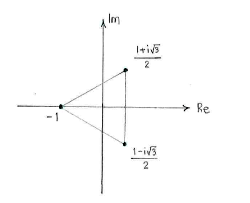Lösung 3.3:2b
Aus Online Mathematik Brückenkurs 2
K (Lösning 3.3:2b moved to Solution 3.3:2b: Robot: moved page) |
|||
| (Der Versionsvergleich bezieht 8 dazwischen liegende Versionen mit ein.) | |||
| Zeile 1: | Zeile 1: | ||
| - | {{ | + | Wir bringen zuerst alle Zahlen in Polarform. |
| - | < | + | |
| - | {{ | + | {{Abgesetzte Formel||<math>\begin{align} |
| - | { | + | z &= r(\cos\alpha + i\sin\alpha)\,\\[5pt] |
| - | < | + | -1 &= 1\,(\cos\pi + i\sin\pi)\, |
| - | {{ | + | \end{align}</math>}} |
| + | |||
| + | Mit dem Moivreschen Satz erhalten wir die Gleichung | ||
| + | |||
| + | {{Abgesetzte Formel||<math>r^3(\cos 3\alpha + i\sin 3\alpha) = 1\,(\cos\pi + i\sin\pi)\,\textrm{.}</math>}} | ||
| + | |||
| + | Die beiden Seiten sind gleich, wenn die Beträge gleich sind und die Argumente sich nur durch ein Vielfaches von <math>2\pi</math> unterscheiden | ||
| + | |||
| + | {{Abgesetzte Formel||<math>\left\{\begin{align} | ||
| + | r^3 &= 1\,,\\[5pt] | ||
| + | 3\alpha &= \pi + 2n\pi\,,\quad\text{(n ist eine beliebige ganze Zahl).} | ||
| + | \end{align}\right.</math>}} | ||
| + | |||
| + | Dadurch erhalten wir | ||
| + | |||
| + | {{Abgesetzte Formel||<math>\left\{\begin{align} | ||
| + | r &= 1\,,\\[5pt] | ||
| + | \alpha &= \frac{\pi}{3}+\frac{2n\pi}{3}\,,\quad\text{(n ist eine beliebige ganze Zahl).} | ||
| + | \end{align}\right.</math>}} | ||
| + | |||
| + | Für jede dritte ganze Zahl <math>n</math>, erhalten wir dieselbe Lösung, also hat die Gleichung nur 3 Lösungen - eine für <math>n=0</math>, für <math>n=1</math> und für <math>n=2</math>). | ||
| + | |||
| + | {{Abgesetzte Formel||<math>z=\left\{\begin{align} | ||
| + | &1\cdot \Bigl(\cos\frac{\pi}{3} + i\sin\frac{\pi}{3}\Bigr)\\[5pt] | ||
| + | &1\cdot \Bigl(\cos\pi + i\sin\pi\Bigr)\\[5pt] | ||
| + | &1\cdot \Bigl(\cos\frac{5\pi}{3} + i\sin\frac{5\pi}{3}\Bigr) | ||
| + | \end{align}\right. | ||
| + | = | ||
| + | \left\{\begin{align} | ||
| + | &\frac{1+i\sqrt{3}}{2}\,,\\[5pt] | ||
| + | &-1\vphantom{\bigl(}\,,\\[5pt] | ||
| + | &\frac{1-i\sqrt{3}}{2}\,\textrm{.} | ||
| + | \end{align} \right.</math>}} | ||
| + | |||
| + | Wir sehen, dass die Wurzeln ein symmetrisches Polygon bilden. In diesem Fall erhalten wir ein Dreieck, da wir 3 Lösungen haben. | ||
[[Image:3_3_2_b.gif|center]] | [[Image:3_3_2_b.gif|center]] | ||
Aktuelle Version
Wir bringen zuerst alle Zahlen in Polarform.
| \displaystyle \begin{align}
z &= r(\cos\alpha + i\sin\alpha)\,\\[5pt] -1 &= 1\,(\cos\pi + i\sin\pi)\, \end{align} |
Mit dem Moivreschen Satz erhalten wir die Gleichung
| \displaystyle r^3(\cos 3\alpha + i\sin 3\alpha) = 1\,(\cos\pi + i\sin\pi)\,\textrm{.} |
Die beiden Seiten sind gleich, wenn die Beträge gleich sind und die Argumente sich nur durch ein Vielfaches von \displaystyle 2\pi unterscheiden
| \displaystyle \left\{\begin{align}
r^3 &= 1\,,\\[5pt] 3\alpha &= \pi + 2n\pi\,,\quad\text{(n ist eine beliebige ganze Zahl).} \end{align}\right. |
Dadurch erhalten wir
| \displaystyle \left\{\begin{align}
r &= 1\,,\\[5pt] \alpha &= \frac{\pi}{3}+\frac{2n\pi}{3}\,,\quad\text{(n ist eine beliebige ganze Zahl).} \end{align}\right. |
Für jede dritte ganze Zahl \displaystyle n, erhalten wir dieselbe Lösung, also hat die Gleichung nur 3 Lösungen - eine für \displaystyle n=0, für \displaystyle n=1 und für \displaystyle n=2).
| \displaystyle z=\left\{\begin{align}
&1\cdot \Bigl(\cos\frac{\pi}{3} + i\sin\frac{\pi}{3}\Bigr)\\[5pt] &1\cdot \Bigl(\cos\pi + i\sin\pi\Bigr)\\[5pt] &1\cdot \Bigl(\cos\frac{5\pi}{3} + i\sin\frac{5\pi}{3}\Bigr) \end{align}\right. = \left\{\begin{align} &\frac{1+i\sqrt{3}}{2}\,,\\[5pt] &-1\vphantom{\bigl(}\,,\\[5pt] &\frac{1-i\sqrt{3}}{2}\,\textrm{.} \end{align} \right. |
Wir sehen, dass die Wurzeln ein symmetrisches Polygon bilden. In diesem Fall erhalten wir ein Dreieck, da wir 3 Lösungen haben.

